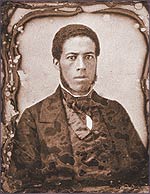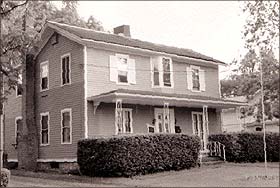


 |
 |
Issue Contents : : Feature Stories : : History's House : : Page [ 1 2 ]
History's HouseOlivia Cousins' quest to restore and honor an important piece of African American history centers around the home of black abolitionist John Mercer Langston.
 |
|
| John Mercer Langston (Courtesy of Oberlin Archives) |
|
It took Cousins more than a year to find Langston House, the vacant historic Oberlin dwelling to which her goddaughter, Acacia Reed '00, had alerted her. (Cousins' daughter, Aisha '00, was also a student at the time.) During visits to campus, Cousins would drive down East College Street in search of a grand and meticulously kept home--which is why, she said, that she didn't find it sooner.
"I wanted to cry," she said, remembering her first reaction to the home's lackluster appearance. "I thought, ‘How could they let this happen?' But then the more I read about the home and its original owner, the more I knew that I was on the right path. If I didn't make an offer on this property, I thought, the house would be lost forever."
Built in 1855, the home's first owner was noted black abolitionist and civil rights leader John Mercer Langston, an 1849 Oberlin graduate and great-uncle to poet Langston Hughes. Langston's remarkable life was filled with firsts: he was the first black lawyer to practice in Ohio, he assembled the nation's first black regiment in preparation for the Civil War, and he served as the first African American elected to Congress from Virginia.
Langston and his wife, Caroline Wall, also an Oberlin graduate, acquired the house in 1856 in exchange for Langston's 50-acre family farm in Brownhelm, Ohio. They were the first black family to live in the predominantly white Oberlin neighborhood, and did so for 15 years, offering their residence as a meeting place for the development of work against the Fugitive Slave Act.
According to the late Oberlin historian Geoffrey Blodgett '53, John Mercer Langston quickly established a respected law practice in town and emerged as the acknowledged leader of the local black community. "In January 1863, when news arrived in Oberlin of the Emancipation Proclamation, Langston read the document to a packed crowd in the College chapel," Blodgett wrote. "Amid rockets, bonfires, and rifle salutes, black townsmen marched up East College to Langston's house to honor the event."
 |
|
| Langston
House, early 1980s (Courtesy of Geoffrey and Jane Blodgett) |
|
Langston left Oberlin in 1871 to work with the Freedmen's Bureau and later taught at Howard University's law school. During the next century, his property changed hands several times and in 1974 was added to the National Register of Historic Places. Oberlin's Student Cooperative Association (OSCA) took possession of the house in 1987, until mounting repair costs prompted its sale in 2000.
"Restoring this house is a lot of work, but whenever I have doubts, I pray,
and someone is sent my way, or something happens to keep me going," said
Cousins, her rubber gloves dripping suds onto the floor.
On this particular day, encouragement came in several forms. Three
neighbors stopped by to volunteer with repair work, and Marion Smith,
an admirer
of the home unknown to Cousins, paid an unexpected visit. A teacher
from Richmond,
Virginia, Smith said he'd noticed activity in the house while visiting his aunt earlier
that week and decided to investigate. Welcoming her unplanned guest, Cousins
offered a tour of the home and a copy of Langston's autobiography, which
she keeps piled on a desk in the parlor.